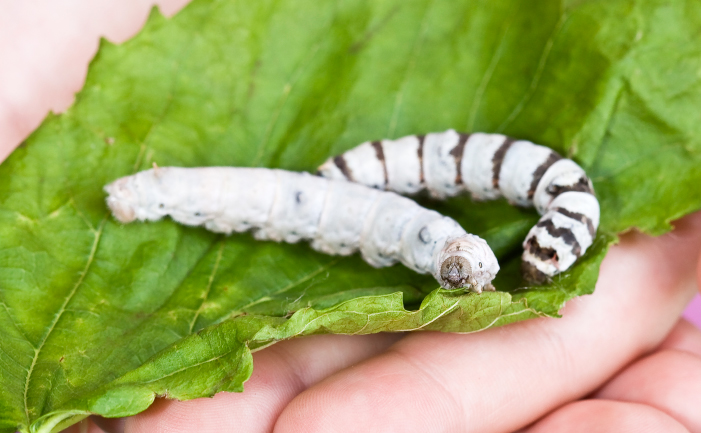
Don visited the Suzhou No. 1 Silk Factory Co, Ltd. He looked at silkworms feeding on mulberry leaves, cocoon boiling and silk spinning.
The Chinese first domesticated silkworms about 5,000 years ago, and for 3,000 years only the Chinese knew how to produce silk. According to Chinese legend, silk was discovered when Emperor Huangdi ordered his wife Xilingshi to find out what was eating his mulberry leaves. She found white caterpillars eating the leaves and spinning shiny cocoons. When she dropped a cocoon into hot water a slender thread of silk unwound itself from the cocoon. Then as today, silk was a luxury item. Silk fabrics travelled the famous caravan route from China to Rome, known as the Silk Road, until 6 AD when two Persian monks smuggled a few silkworm eggs out of China in a hollow walking stick.
Silk Moth
The silkworm is one stage in the development of the silk moth (Bombyx mori). Silkworms start life as eggs. They grow to about 70 times their original size and shed their skin four times. When the silkworm matures it spins a fat, soft, creamy white cocoon around itself in figure eight loops for protection during the sleeping stage. The cocoon is made from one continuous thread of fluid silk, produced in the worm’s modified salivary glands, which hardens on contact with the air. During the next two to three weeks the pupa (an insect in the non-feeding, transformation stage between caterpillar and moth) develops. It emerges from the cocoon as a wet, bedraggled moth with six jointed legs, two pairs of wings and two feathery feelers. Once its crumpled wings have expanded and dried, the moth is a beautiful pearly white colour. Silk moths cannot fly because their bodies are too heavy in relation to their wings. They flutter about until they find a mate and only live long enough to produce another generation. Males die soon after mating while the female dies once she has laid sticky, pale yellow eggs. The complete cycle takes two months. Today, silkworms only survive in captivity, because they have lost the ability to fly.
Silk Spinning
There are different kinds of cocoons – twin, single, dirty and broken. Twin cocoons contain two pupa – the silk is twisted and hard to spin but can be used. Dirty cocoons are stained by the silkworm, and broken cocoons have holes in the sides where the moths have emerged. Of the single cocoons the best are produced in spring. The filament of spring cocoons are the longest (around 1,600 metres) and strongest.
The cocoons are boiled for 20 minutes to dissolve surface gum. The cocoons are then put into hot water, and a straw brush is used to find the ends of the strands. Eight or nine strands are twisted into one thread and the raw silk is wound onto a small spool. Next the silk is rewound onto a larger spool, checked for breakages, packed and sent to a dye factory. It takes 500 spring cocoons to make a man’s necktie and 2,000 spring cocoons to make a man’s t-shirt.
Further information
Suzhou No. 1 Silk Factory Co. Ltd
94 Nanmen Road
Suzhou 215007 China
Phone: +86 512 656 13733
Web: www.1st-silk.com


